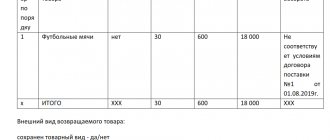Purchase and refusal. A familiar situation that any of us have been in at least once. We bought a thing, liked it in the store, but tried it on at home - no. And the style is a little different from what you need, and doesn’t match the color, and why? We spent the last of our money on it; it would have been better to save it for a vacation. What to do?
If you bought a quality item in a store, but for some reason changed your mind and are not going to use it, you have the right to refuse it and demand a refund from the seller in accordance with paragraph 1 of part 2 of article 25 of the Law of the Russian Federation No. 2300-1 dated 02/07/1992 “On the protection of consumer rights.”
Do you need to file a statement or claim?
To request the return of a purchase that has no defects, an application for the return of goods of proper quality is written. An application should not be confused with a claim, which is a mandatory part of the pre-trial dispute resolution mechanism when it comes to a low-quality product. Or when the rights of a party to a contract are violated.
In our case, we simply write a letter of demand (application) to the seller to fulfill the right granted to us by the Law to return the item to the store and receive the money that was paid for it.
If the seller refuses to return the money paid for the purchase, the consumer has the right to go to court.
Together. When not written together with adjectives
It is written together not with adjectives that are not used without:
Rainy day
Countless Treasures
Ridiculous incident
It is not written together with adjectives, which do not lose their affirmative meaning, but acquire the opposite meaning. Such adjectives have synonyms without:
Unhappy (sad)
Small (small)
Shallow (shallow)
Fickle (changeable)
It is written together not with adjectives in the presence of the words very, completely, extremely, extremely, partly, very, almost, completely, completely, extremely:
Very bad
Extremely untrue
Completely imprudent
Almost invisible
How to make an application?
Is there a single form?
The legislator did not provide a single form. However, the store may offer you an application form for an exchange or refund for the product. But if it doesn’t exist, you’ll have to compose it yourself. There is nothing complicated, there is no official form of the document.
What must be included in the letter?
In the upper right corner write the so-called “header”: where (name and address of the store where you bought the item), from whom (last name, first name, patronymic, your address, phone number).
Below by.
Start with the next line and describe your situation:
“___”__________ in the store “___________” I purchased _______________ (indicate the article number from the product label, the color of the item, its price), which is confirmed (sales and/or cash receipt, or testimony - remember about the girlfriend?).
I have no complaints about the quality of the product, but I cannot use it for its intended purpose (here you forget about the mood and specify the details of the return: the style, or size, or color does not fit - paragraph 1, part 1 of Article 25 of the Law).
Be sure to write if the required product is not available in the store, then you require a refund on the basis of Part 2 of Article 25 of the Law.
Don't forget to indicate the bank details where the store will need to transfer the money or specify that you want to receive cash. Remind the seller that if the money is not returned within three days of the request, then you have the right to go to court. Below, put the date of application, sign and decipher the signature.
We do not recommend completing the documents yourself. Save time - contact our lawyers by phone:
8 (800) 350-14-90
Number of copies
Write the application in two copies and hand it to the seller (or senior seller, or store director).
On the buyer's letter, the seller must put a mark of receipt, his signature and today's date.
Not with an adjective as a predicate, not with an adjective as a determiner
The syntactic role of the relative adjective should also be taken into account:
The adjective with not in the function of the predicate conveys the generally negative meaning of the sentence and is therefore written separately.
The amount is not round.
This man is not from here.
The adjective with not in the defining function may not convey a negative meaning:
The bill is not a round sum.
It was not a local person who came up.
Sometimes a combined or separate spelling not with an adjective is determined by the possibility of double interpretation of the text:
The apple is not tasty (it is claimed that it is bad).
The apple is not tasty (it is denied that it is tasty).
Submission deadlines
The period for exchange or return of goods is fourteen days (not counting the day of purchase).
In order not to be confused about how to calculate deadlines, in calendar or working days, let us turn to Chapter 11 of the Civil Code of the Russian Federation (hereinafter referred to as the Civil Code of the Russian Federation), because the Law in this matter leaves the buyer room for imagination.
Articles 190-194 of the Civil Code of the Russian Federation state that the period is determined by the calendar date. If the last day of the event falls on a non-working day (weekend or holiday), the end date is considered to be the next working day. In our case, 14 calendar days to return the goods, not counting the date of purchase.
Read about when and under what conditions you can return a product if it doesn’t suit you here.
Results
The resulting tax overpayment can be returned from the budget. To do this, you must submit an application in the prescribed form to the Federal Tax Service Inspectorate, indicating in this document the necessary codes, taxpayer data, the period of the overpayment, its amount and details by which the overpayment will be returned.
Sources:
- Tax Code of the Russian Federation
- Order of the Federal Tax Service of Russia dated February 14, 2017 N ММВ-7-8/ [email protected]
You can find more complete information on the topic in ConsultantPlus. Free trial access to the system for 2 days.
Deadline for receiving a response from the seller
Within three calendar days, the seller is obliged to respond and return the money: credit it to the current account specified in the application or give it in cash (paragraph 1, part 2, article 25 of the Law).
If the seller does not give an answer, should the buyer write a claim?
Now the buyer’s rights have been violated and you can safely file a claim demanding a refund. There is nothing difficult in drawing up a claim, but if you have no time or are not confident in your abilities, it is better to draw up an agency agreement with a specialist (attorney) who will defend your interests in relations with the store administration, and, in the future, in court.
We do not recommend completing the documents yourself. Save time - contact our lawyers by phone:
8 (800) 350-14-90
Apart. When not with adjectives it is written separately
It is written separately, not with adjectives, if there is or is implied opposition:
The lake was not round, but oval.
We bought not a big, but a small cake.
Conjunctions a, but do not necessarily mean opposition.
The motor is not big, but small. There is a contrast - it is written separately.
The motor is not big, but powerful. There is no opposition, the engine is both large and powerful - it is written together.
It is not written separately with relative adjectives, since they cannot form words that are opposite in meaning:
The fence is not brick
The weather is not spring
It is also not written separately with qualitative adjectives denoting color and some others:
The paint is not yellow.
The paper is not white.
The shirt is not dirty.
It is not written separately with adjectives, if the negation is logically emphasized (usually in interrogative sentences; such an adjective is placed in preposition): Isn’t this the correct answer? (cf.: Isn’t this answer correct? - i.e. 'erroneous'); Are you wearing a new suit?
What if the product was purchased remotely?
- You can refuse a product without giving any reason at any time after making a purchase before its delivery and within 7 calendar days after it. The seller should not offer you a replacement item. The consumer has the right to buy and refuse the product and demand the money paid for it (paragraph 1, part 4, article 26.1 of the Law).
- Be careful when purchasing goods from the “List of non-food products of good quality that cannot be returned or exchanged for a similar product of other sizes, shape, dimensions, style, color or configuration” (approved by Decree of the Government of the Russian Federation of January 19, 1998 No. 55).
Article 26.1 of the Law says nothing about a ban on purchases from this list. But if you purchase the goods listed in the List, decide to return them, and the seller refuses to accept and return the money for the purchase, then the courts will not always be on your side. - The courier who delivered the purchase is obliged to hand you a paper that will detail all the information about the procedure and terms of return. One copy of the signed document remains with the buyer, the second copy is taken by the seller. If the courier forgot to provide you with information on returning your purchase, you have the right to refuse the goods within 3 months from the date of delivery (paragraph 2, part 4, article 26.1 of the Law).
- You are not required to keep the packaging of the product, unlike when purchasing it in a store.
- The seller must return the money paid for the goods no later than 10 calendar days from the date of your request for their return (paragraph 5, part 4, article 26.1 of the Law).
But when you return the money for your purchase, the seller will deduct from you the costs of delivering the returned goods (paragraph 5, part 4, article 26.1 of the Law).
If you remotely order gold toothbrushes with your own engraving, or a sideboard with the family coat of arms, or a cup with a portrait of your husband, these purchases cannot be returned.
According to paragraph 5 of part 4 of Article 26.1 of the Law, such a thing is considered a product with individually defined properties that only you can use.
Returning goods of proper quality is a simple procedure. The Law “On Protection of Consumer Rights” sufficiently protects the buyer from the willfulness of the seller. But you should always remember the old wisdom: “Buyer and seller - be mutually polite!” and try to plan your purchases before going to the store.
How to spell NOT with participles: together or separately? Rules and examples
A gerund is a special form of a verb that means an additional action. The participle answers the questions “what are you doing?” and “having done what?” Examples: approaching, looking, running, thinking, suffering.
In most cases, the particle NOT with gerunds is written separately, as with other forms of verbs:
Not forgetting about her friends, Sasha constantly wrote letters to them.
We worked without thinking about our own benefit.
No longer hoping for salvation, the victims of the shipwreck were completely desperate.
The patient died without regaining consciousness.
You are the king: live alone. On the road to freedom
Go where your free mind takes you,
Improving the fruits of your favorite thoughts,
Without demanding rewards for a noble deed.
However, there are two exceptions to this rule.
Exceptions. When is NOT written together with a gerund?
Participles are written together with NOT in two cases:
1. If the verb and the gerund formed from it are not used without NOT (this is a prefix or part of the root).
2. If the gerund is formed from a verb with a complex prefix NEDO:
Important! Do not confuse gerunds with the prefix UNDO- and gerunds with the prefix DO- and the negative particle NOT. If the action is not completed, then write separately:
Without finishing the letter, he put down his pen.
The teacher fell silent without finishing his sentence.
Without finishing the performance, the audience was forced to leave the theater.
Who is protected by consumer law?
A consumer is a person who buys a product for personal purposes: for himself, for his family, as a gift. Everyone else buys to resell. Lawmakers believe they will protect themselves. Therefore, the seller’s increased liability arises only in the first case.
Example: buyer - consumer
The man bought a table and four chairs in the Provence style. When lifting into the apartment, the movers scratched the furniture. The buyer asked to return the money and add penalties at an increased rate along with compensation for moral damage - according to the rules for consumers. He bought a table and chairs to have dinner with his family in the kitchen.
Example: buyer is not consumer
The man bought two tables and eight chairs in the Provence style. He indicated a coffee shop on the delivery order form. A week later, the chairs became loose, and guests of the establishment complained about them. The buyer decided to return the product. He can only count on payment and compensation for damages if he provides evidence. Consumer rules do not apply.
Which products can be returned within 14 days
The legislation clearly outlines the procedure for exchanging purchased products or returning money for defective goods. At the same time, you need to know that not every item can be returned, but only those that meet the following requirements:
- The product is not included in the list of products that are included in the exclusion list.
- The appearance has been preserved, including product labels, tags, etc.
- The complete set of the item, consisting of several elements, has been completely preserved.
- If possible, provide a cash receipt confirming that the item was purchased at this outlet.
Note. If a receipt is lost, legislative norms still provide the opportunity to return the item, but in this case the Consumer will have to prove the fact of purchase by involving witnesses and other methods of evidence.







